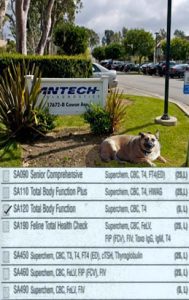Ron Hines DVM PhD
Read about meds that might interfere with your pet’s thyroid gland test results here
Does 1 low thyroid test result = hypothyroidism? Read here
Your Pet’s Total T4 Level = T4 or Total Thyroxine
Your dog or cat’s T4 (Total T4) is a useful screening test to detect an under-active or an over-active thyroid gland (hypothyroidism/ hyperthyroidism). In dogs, an under-active thyroid gland is most common (hypothyroidism). In cats an over-active thyroid gland is most common (hyperthyroidism). Total T4 levels are considerably more accurate in diagnosing an overly active thyroid gland in your cat than they are in diagnosing an under-active thyroid gland in your dog.
The T4 test is not the same thing as the Free T4 test. They are similar, but the free T4 test, is performed using a technique called equilibrium dialysis. It measures the amount of T4 that is actually free and available (biologically active) in your pet’s system and not tied up (attached or bound to) proteins normally present in your dog or cat’s blood. The rapid tests that your veterinarian performs in the office (such as the Idexx SNAP® T4) determines your pet’s total T4 level. That, or a T4 level determined by a national veterinary laboratory, are acceptable screening tests to assess the likelihood of thyroid gland disease. But when the results are unclear, or are borderline, or are not a good fit for the symptoms your pet is experiencing, your veterinarian will probably order other more advanced tests, including a Free T4 test. About 99% of the T4 in your dog and cat’s blood is bound to its blood proteins and not available to be converted into T3. T3 is the active form of thyroid hormone that cells actually utilize to adjust their metabolic rate. When your pet has beginning thyroid gland issues, the Free T4 test will usually pick up the problem before the other tests do.
Although in-office Total T4 tests to check your pet’s thyroid function are fast and convenient for you and your veterinarian, they sacrifice some reliability for that convenience. In-office T4 tests are also an economical way for veterinarians to properly adjust your pet’s dose of thyroid medication as its treatment plan progresses.
Cliffhanger results (= borderline or gray zone T4 readings) and even Free T4 readings are best confirmed through a complete thyroid panel consisting of Free T4, TSH (cTSH) and anti-thyroid antibody (TgAA).
Sometimes the only way to confirm those difficult cases is to simply try a thyroid hormone medication for a few months and observe the effects – under your veterinarian’s close supervision, of course. If an improvement in your dog’s attitude and energy level or a lower blood lipid level (cholesterol, triglycerides) is seen within the first few weeks or a return to a normal hair coat after a longer period, hypothyroidism could have been the underlying cause. There are risks in giving thyroid medications to pets that do not need them – probably the same risks as seen in humans in the same situations. (read here) There are two test procedures used to measure T4, the RIA and the ELISA method. In borderline situations they can yield different results – although that appears to be chiefly due to what different testing laboratories consider normal T-4 levels to be. In borderline situations especially, do not attempt to compare your pet’s thyroid results from one laboratory with results performed at another laboratory – run them all through the same laboratory.
Reasons Why Your Cat Or Perhaps Even A Rare Dog’s T4 Level Might Be High:
If you own a cat that has the symptoms of hyperthyroidism, and it’s T4 level is elevated, it is most likely hyperthyroid. Hyperthyroidism is quite rare in dogs. So high results in a dog need to be confirmed with a complete thyroid panel.
Pets less than one year old tend to to naturally have a slightly higher T4 level. As they age, their T4 levels naturally decrease. So, what might be considered normal in a young adult pet would not necessarily be normal in a geriatric dog or cat. In the very rare instances where dogs have abnormally high T4 levels, the cause is often a tumor(s) present in their thyroid gland. Some veterinarians believe that pets that are in heat (estrus) or pregnant can also have slightly higher T4 levels. I don’t know if any scientific work has been done to confirm that. But we do know that in pregnant women, T4 and T3 levels are about 1.5 times higher than normal, while free T3 and free T4 are often lower than normal.
Reasons Why Your Dog Or Perhaps Even Your Cat’s T4 Level Might Be Low:
Decreased T4 levels in dogs can mean that your pet is hypothyroid. But as I mentioned before, a non-thyroid illness depressing T4 levels has to be ruled out before that diagnosis is made. Many pet owners associate chubby cats (and people) with sluggish thyroid gland function (low T4). Hypothyroidism is not why most cats (or people) become overweight. It is because we or our furry companions eat too much and exercise too little. True low T4 levels in cats are quite rare. When they do occur, it is usually in a kitten or puppy that was born a dwarf. (read here & here) We are making some progress in understanding the genetics that are involved in hypothyroidism in dogs. (read here)
As I mentioned, a wide variety of chronic diseases that have nothing directly to do with primary disease of the thyroid gland also cause depressed T4 levels. So, your vet will probably want to perform a complete thyroid panel, and do a thorough general health evaluation on your dog or cat before making any decisions. Many medications can also lower your pet’s T4 levels. Phenobarbital, given for epilepsy, is occasionally one of them. (read here)
Certain breeds of dogs – those that were bred to run fast and chase animals with their eyesight rather than their nose – have lower T4 levels (about 1/3 – 1/2 lower) naturally. That group are called sight hounds (greyhounds, salukis, Afghan hounds, whippets, borzois, Irish wolfhounds, pharaoh hounds, Ibizan hounds, etc.)
Complementary Tests:
CBC/ WBC and blood chemistry values, thyroid panel, T3 suppression test. FreeT4 levels that are borderline should be rechecked in 2-3 months.
DxMe



 See What Normal Blood & Urine Values Are
See What Normal Blood & Urine Values Are Causes Of Most Abnormal Blood & Urine Tests
Causes Of Most Abnormal Blood & Urine Tests